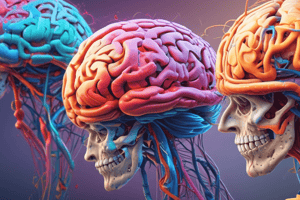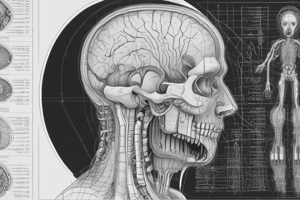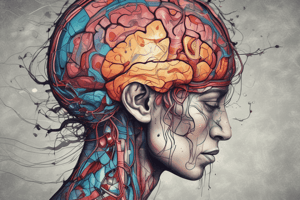Podcast
Questions and Answers
What typically triggers the signs and symptoms of CNS neoplasms?
What typically triggers the signs and symptoms of CNS neoplasms?
- When there is a decrease in neuronal activity
- When there is an increase in cerebral blood flow
- When tumor cells release growth factors
- When there is a blockage of CSF flow (correct)
What describes drop metastasis in relation to CNS tumors?
What describes drop metastasis in relation to CNS tumors?
- When tumor cells spread through the bloodstream
- When secondary tumors develop in the brain
- When primary CNS tumors metastasize to the spinal cord (correct)
- When CNS tumors metastasize to distant organs
What is a common focal symptom of a primary brain tumor?
What is a common focal symptom of a primary brain tumor?
- Seizures (correct)
- Gait disorder
- Cognitive difficulties
- Nausea and vomiting
What function does ependymal cells serve in the CNS?
What function does ependymal cells serve in the CNS?
Which characteristic is associated with high-grade astrocytomas?
Which characteristic is associated with high-grade astrocytomas?
What is the peak age of incidence for low-grade astrocytomas in children?
What is the peak age of incidence for low-grade astrocytomas in children?
Which risk factor is least likely associated with gliomas?
Which risk factor is least likely associated with gliomas?
Where are low-grade astrocytomas primarily located?
Where are low-grade astrocytomas primarily located?
Which symptom is most commonly associated with Carpal Tunnel Syndrome?
Which symptom is most commonly associated with Carpal Tunnel Syndrome?
Which of the following treatments is recommended for Charcot-Marie-Tooth Disease?
Which of the following treatments is recommended for Charcot-Marie-Tooth Disease?
What is the primary cause of Charcot-Marie-Tooth Disease type 1?
What is the primary cause of Charcot-Marie-Tooth Disease type 1?
What is the most significant pressure threshold associated with Carpal Tunnel Syndrome?
What is the most significant pressure threshold associated with Carpal Tunnel Syndrome?
Which demographic is most likely to be affected by Carpal Tunnel Syndrome?
Which demographic is most likely to be affected by Carpal Tunnel Syndrome?
Which of the following describes a test that assesses Thoracic Outlet Syndrome?
Which of the following describes a test that assesses Thoracic Outlet Syndrome?
What is the primary symptom associated with Bell's Palsy?
What is the primary symptom associated with Bell's Palsy?
Which of the following is NOT a common factor contributing to diabetic neuropathy?
Which of the following is NOT a common factor contributing to diabetic neuropathy?
What effect does hyperglycemia have on nerve function in diabetic neuropathy?
What effect does hyperglycemia have on nerve function in diabetic neuropathy?
Which nerve is commonly associated with symptoms of Cubital Tunnel Syndrome?
Which nerve is commonly associated with symptoms of Cubital Tunnel Syndrome?
Flashcards are hidden until you start studying
Study Notes
CNS Disorders
- Signs and symptoms of CNS neoplasms typically arise when there is a blockage of CSF flow, leading to increased intracranial pressure.
- Drop metastasis refers to the spread of primary CNS tumors to the spinal cord.
- CNS tumors affect the body by:
- Compressing cerebral tissue, causing cerebral edema and increased ICP.
- Causing vasogenic edema.
- Releasing chemical substances that disrupt the blood-brain barrier (BBB), leading to increased edema.
- Increasing permeability of capillary endothelial cells.
- To compensate for edema and maintain ICP, the brain reduces:
- Brain tissue volume
- CSF volume
- Cerebral blood volume
- General symptoms of a primary brain tumor include:
- Headaches with or without nausea or vomiting
- Cognitive difficulties
- Personality changes
- Gait disorders
- These symptoms occur due to secondary increased ICP or compression of CSF, potentially leading to hydrocephalus.
- Focal symptoms of a primary brain tumor can include:
- Hemiparesis (weakness on one side of the body)
- Aphasia (difficulty with language)
- Visual defects
- Seizures are common, occurring in 90% of patients with low-grade gliomas.
- Gliomas are the most prevalent type of primary brain tumor.
- Glial cells include:
- Astrocytes
- Oligodendrocytes
- Ependymal cells
- Ependymal cells line the ventricles of the brain.
- Low-grade astrocytomas are the most common type of brain tumor in children.
- Risk factors for gliomas include:
- Industrial exposures
- Infection
- Trauma
- Immunosuppression
- Radiation
- Maternal diet may influence childhood tumors.
- The peak age of incidence for astrocytomas is:
- 45-55 years old for adults
- 2-10 years old for children
- Low-grade astrocytomas typically occur in the cerebrum.
- Initial signs and symptoms of low-grade astrocytomas include headaches due to increased ICP.
- Characteristics of high-grade astrocytomas include:
- More common in adults than children
- Located in the frontal and temporal lobes
- Malignant, aggressive, and fast-growing
- Common signs of oligodendrocytes include:
- History of seizures and chronic headaches
- Location in the cerebral hemisphere
- Typically affecting adults
- Slow-growing, solid, and calcified tumors
- Ependymomas are a type of tumor that arises from ependymal cells, which line the ventricles of the brain.
Hereditary Neuropathies - Charcot-Marie-Tooth Disease (CMT)
- Affects 1 in 2500 people in the US.
- Affects approximately 2.6 million people worldwide.
- Primarily an autosomal dominant condition
- CMT 1 and 2 present with similar clinical features, caused by mutations in proteins that support Schwann cell myelination.
- CMT 1 features extensive demyelination with Schwann cell "bulb" formation.
- CMT 2 affects the anterior horn cells and dorsal root ganglia of the lumbar levels.
CMT Progression and Presentation
- Slowly progressive disease.
- Causes distal lower extremity symmetric weakness, atrophy, and diminished reflexes.
- Affects dorsiflexors and evertors, resulting in a “steppage gait”.
- Proprioception and cutaneous sensation are lost in the lower extremities, especially in CMT 1.
- Distal upper extremity symptoms may appear in later stages.
CMT Treatment
- Primarily symptomatic, focusing on function.
- Orthotics used to address foot deformities.
- Skin care is essential due to risk of lesions in areas with sensory loss.
- Range of motion exercises and stretches to prevent contractures.
- Strengthening exercises provide benefit, but not cures due to the degenerative nature of the disease.
Compression and Entrapment Syndromes - Carpal Tunnel Syndrome (CTS)
- Most common entrapment neuropathy.
- Symptoms include pain, tingling, numbness, and parasthesias in the median nerve distribution.
- Muscle weakness is also common.
- Affects the median nerve specifically due to compression at the carpal tunnel, which involves flexor tendons, the median nerve, the deep branch of the ulnar nerve, and the ulnar artery.
- Incidence is 1-3 cases per 1000 subjects per year.
- Prevalence is 50 cases per 1000 subjects in the general population.
- More common in women (9.2% prevalence) than men (0.6% prevalence).
- Over 500,000 carpal tunnel surgeries are performed annually.
- Normal compartment pressure ranges from 7-8 mm Hg, but with CTS, pressures can exceed 30 mm Hg.
- High pressure leads to ischemia of the median nerve.
Median Nerve
- Compression results in wasting of muscles innervated by the median nerve, including:
- Flexor pollicis brevis (FPB)
- Opponens pollicis (OP)
- Abductor pollicis brevis (APB)
Ulnar Nerve
- Vulnerable to compression in two locations:
- Cubital tunnel
- Pisiform – Guyon’s canal
Thoracic Outlet Syndrome
- Caused by compression of the brachial plexus in the thoracic outlet, which is located between the clavical and the first rib.
- Compression involves the subclavian artery, brachial plexus, and the scalene muscles.
Adson’s Test
- Used to assess for thoracic outlet syndrome.
- The patient takes a deep breath and turns their head towards the affected side, while the examiner palpates the radial pulse. A diminished or absent pulse indicates a possible compression.
Metabolic Neuropathies - Diabetic Neuropathy
- Progressive nerve fiber loss and atrophy.
- Degeneration of neural function leads to peripheral sensory and motor loss.
- Usually occurs in a distal symmetric pattern.
- Many forms are subclinical depending on the nerves involved.
- Caused by vascular changes, altered ATP synthesis, and reduced concentrations of nerve growth factor.
- Pathogenesis related to hyperglycemia which leads to microvascular injury, vasoconstriction, and decreased blood flow to the nerves.
Hyperglycemia and the Polyol Pathway
- High glucose concentrations activate the enzyme aldose reductase which converts glucose to sorbitol.
- Sorbitol causes osmotic stress in cells, and needs to be converted to fructose by sorbitol dehydrogenase.
- Some parts of the body have low levels of sorbitol dehydrogenase, including the retina of the eye, the kidney, and neurons.
Compression and Entrapment Syndromes - Idiopathic Facial Paralysis (Bell’s Palsy)
- Unilateral involvement of the facial nerve (CN VII).
- Affects 20 per 100,000 people annually.
- Most common in those aged 20-40 years.
- Cause is unknown, but viruses and cytokines are thought to play a role.
- Antibodies to the herpes virus are found in patients with Bell’s Palsy.
- Early symptoms include pain at the mastoid process which suggests an inflammatory process causing demyelination.
- Tumors can also compress CN VII, and the condition is more common in patients with diabetes and pregnant women.
Bells Palsy Clinical Manifestations
- Unilateral facial paralysis develops rapidly.
- Asymmetrical facial appearance.
- The facial nerve innervates the stapedius muscle, and hearing abnormalities may be present.
- Facial nerve innervates autonomic fibers for taste, lacrimation, and salivation which can be affected.
Bells Palsy Diagnosis
- Observation of muscles of facial expression.
- Electromyography used to test for degenerated nerves.
Bells Palsy Treatment
- High doses of steroids to prevent permanent damage.
- Antiviral medications such as acyclovir may be helpful.
- Individuals treated within 3 days of paralysis have a 100% recovery rate.
- Recovery rate decreases to 84% by day 4 if treatment does not occur.
- Eye patches and artificial tears are useful.
- Incomplete involvement typically recovers completely over a few weeks.
Studying That Suits You
Use AI to generate personalized quizzes and flashcards to suit your learning preferences.



